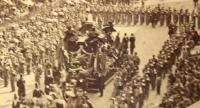When President Abraham Lincoln (1809-1865) was assassinated, his body was carried by train and by carriage through 180 cities before reaching Springfield, Illinois, where it was buried. The route passed through New Jersey and Princeton students are reported to have stood in silence as it passed. The train stopped briefly in New Brunswick and Newark, before the body was transferred to a ferry, which carried it from Jersey City to New York City.
Once in NYC, the casket remained at City Hall Park all day and through the next morning, when it was loaded into a glass-sided hearse pulled by sixteen horses and taken to the Hudson River Railway Depot at 10th Avenue and 30th Street. This albumen photograph taken on April 25 shows the procession moving up Broadway, just south of Astor Place. The Church of the Messiah (Unitarian) is seen at the center of the frame.
The platform of the hearse was fourteen feet long, eight feet wide, and five feet from the ground, so the crowds could see the coffin through the glass. The New York Times’ Henry J. Raymond wrote that “the hearse, drawn by six [sic] gray horses, heavily draped in black, took its place in the procession, headed by General [John A.] Dix and other officers, escorted by the Seventh Regiment, and the whole cortege moved, through densely crowded streets and amidst the most impressive display of public and private grief, to the City Hall.” (Henry Raymond, The Life of Abraham Lincoln, John Shaw Pierson Civil War Collection W96.587.75.3)


Indeed, during the nation’s darkest hour, Abraham Lincoln was able to ride above the storms of his life and lead as President. While he was never able to achieve complete emancipation from his psychological problems like the freedom that was won for the Negro slaves, Abraham Lincoln heroically faced the obstacles and hardships to become America’s most revered president.
Thanx for displaying this great old photo. I did a tremendous amt. of research on the NYC funeral for Lincoln ( I give a multi-media talk about it, and my chapter about it appears in the 2010 book, "The Lincoln Assassination," ed. by Messrs. Holzer, Symonds, and WIlliams.)and offer a couple of minor points of correction.
1. This hearse was not glass-enclosed. A smaller hearse, used the prev. day in taking the casket to City Hall upon its arrival from NJ was.
2. This is, indeed, the corner of Bway and Astor Place, not just a little south of it.
If you will all study the photo carefully, you will notice that everyone has stopped marching, and a few people in the procession are actually looking right into the camera's lens. I had often wondered how that could have happened. How could a cameraman have had the power to stop the procession just for him?
It turns out that the procession was halted because up ahead there was a problem in the line. I believe some military company got into the line out of order, and it had to be corrected, crazy as it sounds. (Maj. DIx was livid, as he had to get to the RR station at 4 pm. As a result, he odered the pace of the funeral sped up, much to the consternation of the members of the 7th regiment, who could no longer show off their great toy-soldier -like disciplined and syncronous march. I think I read this in a history of the 7th regiment. Ah-hah! That's why the procession grounded to a halt. A photographer was possibly there with his camera all set up to take his picture anyway, since it was just down the block and around the corner from Cooper Union, where would-be candidate Lincoln had made his mark in a lecture in 1860. The unknown photographer just got lucky.